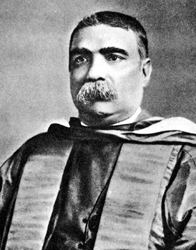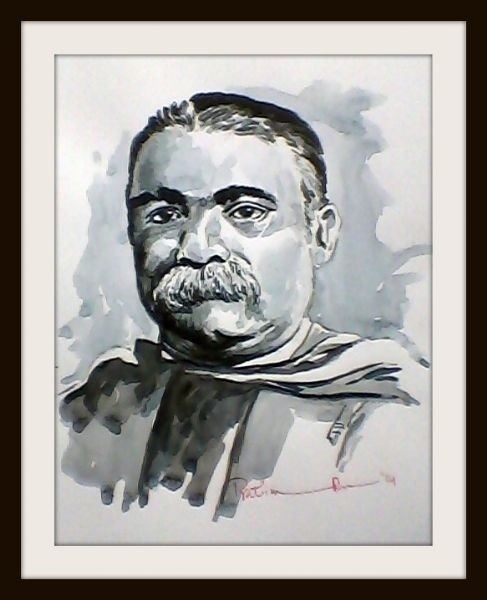Nationality Indian Ethnicity Bengali | Children Syama Prasad Mukherjee Name Ashutosh Mukherjee | |
 | ||
Pen name The Tiger of Bengalবাংলার বাঘ Occupation Educator and the second indian Vice-Chancellor of the University of Calcutta Parents Ganga Prasad Mukherjee, Jagattarini Devi Books Juvenile Justice: An In-depth Study on Matters Relating to Children | ||
Alma mater University of Calcutta | ||
Ashutosh mukherjee
Sir Ashutosh Mukherjee, CSI (Bengali: আশুতোষ মুখোপাধ্যায়) originally spelt as Sir Asutosh Mookerjee (29 June 1864 – 25 May 1924) was a prolific Bengali educator and the second Indian Vice-Chancellor of the University of Calcutta for four consecutive two-year terms (1906–1914) and a fifth two-year term (1921–23). Perhaps the most emphatic figure of Indian education, he was a man of great personality, high self-respect, courage and towering administrative ability. He became the first student to be awarded a dual degree (MA in Mathematics and Physics) from Calcutta University and received the prestigious Premchand-Roychand scholarship.
Contents
- Ashutosh mukherjee
- Ashutosh Mukherjee Wikipedia audio article
- Early life
- Contribution to education
- Other positions held
- References

Mukherjee was responsible for the foundation of the Bengal Technical Institute in 1906 and the College of Science of the Calcutta University in 1914 and also played a vital role in the founding of the University College of Law. The Calcutta Mathematical Society was also founded by Mukherjee in 1908 and he served as the president of the Society from 1908 to 1923. He was also the president of the inaugural session of the Indian Science Congress in 1914. The Ashutosh College was also founded under his stewardship in 1916, when he was Vice-chancellor of University of Calcutta.

Ashutosh Mukherjee was knighted in 1911 for his contributions to education in India. He was often called "Banglar Bagh" meaning the "Tiger of Bengal" for his high self-esteem, courage, academic integrity and a general intransigent attitude towards the British Government. Sir Ashutosh Mukherjee died in 1924 at Patna, Bihar. His son Syama Prasad Mookerjee founded the Bharatiya Jana Sangh.
Ashutosh Mukherjee | Wikipedia audio article
Early life

Ashutosh Mukherjee was born on 29 June 1864 at Bowbazar, Kolkata to Jagattarini Devi and Ganga Prasad Mukherjee, a well-known doctor who founded the South Sub Urban School in Calcutta. Brought up in an atmosphere of science and literature at home, young Asutosh went to the Sisu Vidyalaya at Chakraberia, Bhowanipore and showed an early aptitude for mathematics. When he was young, he met Ishwar Chandra Vidyasagar who was a major influence on him. He was a student of Madhusudan Das. In 1879, at the age of fifteen, he passed the entrance exam of the Calcutta University in which he stood third and received a first grade scholarship. In the year 1880, he took admission at the Presidency College in Kolkata where he met P.C. Ray and Narendranath Dutta who would later become famous as Swami Vivekananda. In 1883 he topped the BA examination at Calcutta University and was awarded the Premchand-Roychand scholarship to complete a postgraduate degree in mathematics. In 1883 S.N. Banerjee wrote an article in news paper Bengalee against the order of Calcutta High court and he was arrested in contempt of court, protests and hartals erupted across the Bengal and other cities then a group of students which leaded by Ashutosh Mukherjee at Calcutta high court. In 1885, he completed an M.A. in mathematics and in 1886, a Masters in Physical Science, making him the first student to be awarded a dual degree from Calcutta University. In the same year he was married to Jogomaya Devi.
Mukherje turned down a job in the Department of Public Instruction to complete his Bachelor of Law degree. During this time, he continued publishing scholarly papers on mathematics and physics. At the age of 24, he became a Fellow of the Calcutta University and helped in its transformation from an examining body into a major centre of learning and research in the Indian subcontinent. He was influential in the University affairs throughout his life, being appointed the Vice-Chancellor from 1906 to 1914 and again from 1921 to 1923. He was instrumental in discovering the talents of C. V. Raman and S. Radhakrishnan.

The French scholar Sylvain Lévi commented :
Had this Bengal Tiger been born in France, he would have exceeded even Georges Clemenceau, the French Tiger. Ashutosh had no peer in the whole of Europe.
Contribution to education
Ashutosh Mukherjee had a vision of the kind of education he wanted young people to have, and he had the acumen and courage to extract it from his colonial masters. He set up several new academic graduate programs at the Calcutta University: comparative literature, anthropology, applied psychology, industrial chemistry, ancient Indian history and culture as well as Islamic culture. He also made arrangements for postgraduate teaching and research in Bengali, Hindi, Pali and Sanskrit. Scholars from all over India, irrespective of race, caste, and gender, came to study and teach there. He even persuaded European scholars to teach at his university. He was one of the first persons to recognise the work of Srinivasa Ramanujan. He also established Asutosh College in South Kolkata in 1916. He laid the foundry stone of Santragachi Kedarnath Institution.
Curzon's education mission in 1902 identified the universities including the Calcutta University, as centres of sedition where young people formed networks of resistance to colonial domination. The cause of this was thought to be the unwise granting of autonomy to these universities in the nineteenth century. Thus in the period of 1905 to 1935, the colonial administration tried to reinstate government control of education. In 1923, Mukherjee refused the post of Vice-Chancellor when Lord Lytton tried to impose conditions on his reappointment.
The Government of India issued a stamp in 1964 to commemorate Sir Ashutosh Mukherjee for his contribution to education.
Other positions held
Mukherjee was a member of the 1917–1919 Sadler Commission, presided over by Michael Ernest Sadler, which inquired into the state of Indian education. He was thrice elected as the president of The Asiatic Society. In 1910, he was appointed the President of the Imperial (now National) Library Council to which he donated his personal collection of 80,000 books which are arranged in a separate section. He was the president of the inaugural session of the Indian Science Congress in 1914. He was a polyglot learned in Pali, French and Russian, and was awarded the titles of Saraswati and Shastravachaspati by the pundits of Bengal for his service to Indian education.
Mukherjee was appointed a Companion of the Order of the Star of India (CSI) in June 1909 and knighted in December 1911.
The epitaph beneath his marble bust at the Ashutosh Museum of Arts at the University of Calcutta reads:
His noblest achievement, surest of them all/ A place for his mother tongue --- in step mother's hall.
